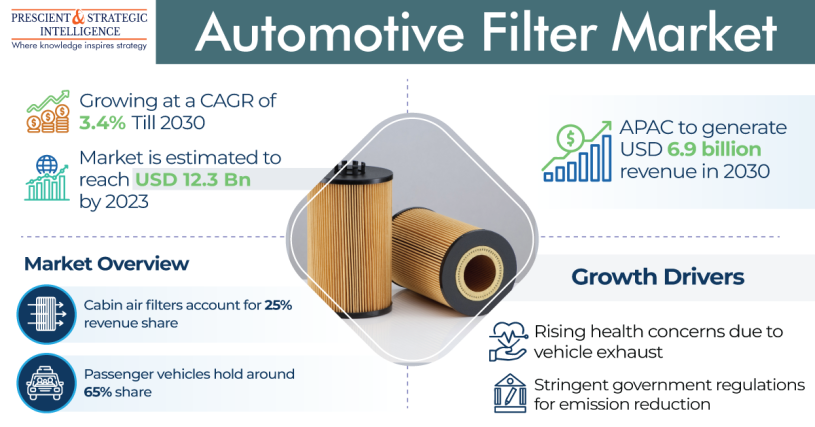The automotive filter market was USD 12.3 billion in 2023, which will increase to USD 15.5 billion, powering at a 3.4% compound annual growth rate, by 2030.
This is because of the rising health worries among individuals, coupled with the growing level of environmental pollution, surging vehicle production and ownership rate, and implementation of strict government laws for emission reduction.
In 2023, the cabin air category, based on type, led the industry, with approximately 25% share, owing to the cost efficiency and high quality of these products. A cabin air filter is utilized to remove risky pollutants from the air supply inside the automobile, including dust and pollen.
In 2023, the passenger vehicles category, based on vehicle, accounted for the larger share, primarily because of the surging need for luxury automobiles. Luxury vehicles offer greater-quality filters for the HVAC systems as well as intake manifolds, for high comfort levels and enhanced automobile performance, respectively.
The commercial vehicles category, on the other hand, was a significant contributor to the industry, primarily because of the increasing e-commerce activities all over the globe. The speedy urbanization has established new e-commerce and retail platforms, which demand effective logistics, therefore resulting in the progression of this category.
The synthetic category, on the basis of medium, was the largest contributor to the automotive filter market. This can be because of the extensive utilization of these types because of their greater filtration effectiveness compared to conventional cellulose filters. This means the former can catch tinier particles, therefore offering greater defense to the engine.
In 2023, the OEMs category, on the basis of distribution channel, accounted for the largest revenue share, of USD 8.0 billion. This can be primarily because of the manufacturing of different kinds of automobiles, such as light commercial vehicles, heavy commercial vehicles, and passenger cars.
In 2023, APAC accounted for the largest share, of 45%. This can be because of the increasing disposable salary of the middle class, the rising urbanization rate, growing automotive production and sales, and the existence of an enormous youth populace in this region.
Moreover, the strong auto component and automotive manufacturing base, coupled with the stringent environmental policy to reduce emissions, boost the industry in China and India.
North America was the second-largest contributor to the industry. This can be primarily because of the surge in the count of industry players in this continent as well as the growing requirement for passenger and commercial vehicles.
With the increasing worries about health owing to vehicle exhaust and the strict environmental rules to reduce emissions, the automotive filter industry will continuously progress in the coming years.

